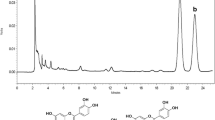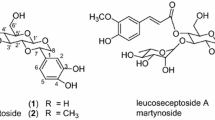Abstract
2-Styrylchromones are a novel class of chromones, vinylogues of flavones (2-phenylchromones), which have recently been found in nature. The best described property of almost every group of flavones and other flavonoids, especially the hydroxylated derivatives, is their capacity to act as antioxidants. Indeed there is a widely accepted view that the positive health effects of flavones are due to their antioxidant activity. As oxidative stress is a main cause of liver toxicity induced by several hepatotoxicants, agents with the ability to protect the liver against reactive pro-oxidant species may be therapeutically useful. The present study evaluated the possible protective activity of six new synthetic polyhydroxylated 2-styrylchromone derivatives against the pro-oxidant hepatotoxicity exerted by tert-butylhydroperoxide (t-BHP) in freshly isolated rat hepatocytes. The cells were preincubated with the 2-styrylchromones in the final concentrations of 3.125, 12.5, 25, 50, 100, and 200 µM for 5 min before treatment with 1.0 mM t-BHP for 30 min (throughout this incubation period the cells were exposed to both compounds). The well-known antioxidant 3-hydroxyflavone (quercetin) was used as positive control. At the end of the 30-min incubation period, aliquots of cells suspensions were taken for measurement of lactate dehydrogenase leakage, thiobarbituric acid reactive substances, reduced glutathione, and oxidized glutathione contents. The tested compounds exhibited in vitro protective activity against t-BHP induced hepatotoxicity (1.0 mM, 30 min). Three of the tested compounds, at the concentrations of 3.125, 12.5, 25, and 50 µM, prevented the t-BHP induced glutathione depletion, lipid peroxidation, and cell death in freshly isolated rat hepatocytes to a comparable potency with that of quercetin.





Similar content being viewed by others
References
Anderson ME (1985) Determination of glutathione and glutathione disulfide in biological samples. Methods Enzymol 113:548–555
Bellomo G, Jewell SA, Thor H, Orrenius S (1982) Regulation of intracellular calcium compartmentation: studies with isolated hepatocytes and t-butyl hydroperoxide. Proc Natl Acad Sci USA 79:6842–6846
Bors W, Heller W, Michel C, Saran M (1990) Flavonoids as antioxidants. Determination of radical scavenging efficiencies. Methods Enzymol 186:343–355
Brion D, Le Baut G, Zammatio F, Pierre A, Atassi G, Belachm L (1991) Preparation of 2-styryl-4-chromanones as anticancer agents. European patent application EP 454:587. Chem Abstr 116:106092k
Cadenas E, Sies H (1982) Low level chemiluminiscence of liver microsomal fractions initiated by tert-butyl-hydroperoxide. Relation to microsomal hemoproteins, oxygen dependence, and lipid peroxidation. Eur J Biochem 124:349–356
Desideri N, Conti C, Mastromarino P, Mastropaolo F (2000) Synthesis and anti-rhinovirus activity of 2-styrylchromones. Antiviral Chem Chemother 11:373–381
Doria G, Romeo C, Forgione A, Sberze P, Tibolla N (1979) Anti-allergic agents. III. Substituted trans-2-ethenyl-4-oxo-4H-1-benzopyran-6-carboxylic acids. Eur J Med Chem 14:347–351
Farghali H, Kamenikova L, Hynie S, Kmonickova E (2000) Silymarin effects on intracellular calcium and cytotoxicity: a study in perfused rat hepatocytes after oxidative stress injury. Pharmacol Res 41:231–237
Farombi EO, Tahnteng JG, Agboola AO, Nwankwo JO, Emerole GO (2000) Chemoprevention of 2-acetylaminofluorene induced hepatotoxicity and lipid peroxidation in rats by kolaviron-A Garcinia kola seed extract. Food Chem Toxicol 38:535–541
Fernandes ER, Carvalho F, Remiao F, Bastos ML, Pinto MM, Gottlieb OR (1995) Hepatoprotective activity of xanthones and xanthonolignoids against tert-butylhydroperoxide-induced toxicity in isolated rat hepatocytes-comparison with silybin. Pharm Res 12:1756–1760
Fernandes ER, Carvalho F, Silva AMS, Santos CMM, Pinto DCGA, Cavaleiro JAS, Bastos ML (2002) 2-Styrylchromones as novel inhibitors of xanthine oxidase. A structure-activity study. J Enzyme Inhib Med Chem 17:45–48
Filipe P, Morlière P, Patterson LK, Hug GL, Mazière JC, Mazière C, Freitas JP, Fernandes A, Santus R (2002) Mechanisms of flavonoid repair reactions with amino acid radicals in models of biological systems: a pulse radiolysis study in micelles and human serum albumin. Biochim Biophys Acta 1572:150–162
Gerwick WH (1989) 6-Desmethoxyhormothamnione, a new cytotoxic styrylchromone from the marine cryptophyte Chrysophaeum taylori. J Nat Prod 52:252–256
Gerwick WH, Lopez A, Van Dyune GD, Clardy J, Ortiz W, Baez A (1986) Hormothamnione, a novel cytotoxic styrylchromone from the marine cyanophyte Hormothamnion enteromorphoides grunow. Tetrahedron Lett 27:1979–1982
Gilani AH, Janbaz KH, Shah BH (1997) Quercetin exhibits hepatoprotective activity in rats. Biochem Soc Trans 25:S619
Groskreutz JL, Bronk SF, Gores GJ (1992) Ruthenium red delays the onset of cell death during oxidative stress of rat hepatocytes. Gastroenterology 102:1030–1038
Jewell A, Monte DD, Richelmi R, Bellomo G, Orrenius S (1986) tert-butyl hydroperoxide induced toxicity in isolated hepatocytes: contribution of thiol oxidation and lipid peroxidation. J Biochem Toxicol 1:13–22
Joyeux M, Rolland A, Fleurentin J, Mortier J, Dorfman, P (1990) tert-butyl hydroperoxide induced injury in isolated isolated rat hepatocytes: a model for studying antihepatotoxic drugs. Planta Med 56:171–174
Kagaya N, Tagawa Y, Nagashima H, Saijo R, Kawase M, Yagi K (2002) Suppression of cytotoxin-induced cell death in isolated hepatocytes by tea catechins. Eur J Pharmacol 450:231
Karton Y, Jiang J, Ji X, Olah ME, Stiles GL, Jacobson KA (1996) Synthesis and biological activities of flavonoids derivatives as A3 adenosine receptor antagonists. J Med Chem 39:2293–2301
Matsuda H, Ninomiya K, Shimodab H, Yoshikawaa M (2002) Hepatoprotective principles from the flowers of Tilia argentea (Linden): structure requirements of tiliroside and mechanisms of action. Bioorgan Med Chem 10:707–712
Nijveldt RJ, van Nood E, van Hoorn DEC, Boelens PG, van Norren K, and van Leeuwen PAM (2001) Flavonoids: a review of probable mechanisms of action and potential applications. Am J Clin Nutr 74:418–425
Pannala AS, Chan TS, O'Brien PJ, Rice-Evans CA (2001) Flavonoid B-ring chemistry and antioxidant activity: fast reaction kinetics. Biochem Biophys Res Commun 282:1161–1168
Pérez-Alvarez V, Bobadilla-Lugo RA, Muriel P, Favari L, Villanueva-Lopez C (1993) Effects of leukotriene synthesis inhibition on acute liver damage induced by carbon tetrachloride. Pharmacology 47:330–336
Pérez-Alvarez V, Bobadilla-Lugo RA, Muriel P (2001) Structure-hepatoprotective activity relationship of 3:4-dihydroxycinnamic acid (caffeic acid) derivatives. J Appl Toxicol 21:527–531
Pinto DCGA, Silva AMS, Almeida LMPM, Cavaleiro JAS, Lévai A, Patonay T (1998) Synthesis of 4-aryl-3-(2-chromonyl)-2-pyrazolines by the 1:3-dipolar cycloaddition of 2-styrylchromones with diazomethane. J Heterocycl Chem 35:217–224
Pinto DCGA, Silva AMS, Almeida LMPM, Cavaleiro JAS (2000) A convenient synthesis of new (E)-5-hydroxy-2-styrylchromones by modifications of the Baker-Venkataraman method. New J Chem 24:85–92
Rice-Evans CA, Miller NJ, Paganga G (1996) Structure-antioxidant activity relationships of flavonoids and phenolic acids. Free Radic Biol Med 20:933–956
Rush GF, Gorski JR, Ripple MG, Sowinski J, Bugelski P, Hewitt WR (1985) Organic hydroperoxide-induced lipid peroxidation and cell death in isolated hepatocytes. Toxicol Appl Pharmacol 78:473–483
Sies H, Summer KH (1975) Hydorperoxide-metabolizing system in rat liver. Eur J Biochem 57:503–512
Wu TW, Zeng LH, Wu J, Fung KP (1993) Morin hydrate is a plant-derived and antioxidant-based hepatoprotector. Life Sci 53:PL213–PL218
Author information
Authors and Affiliations
Corresponding author
Rights and permissions
About this article
Cite this article
Fernandes, E., Carvalho, M., Carvalho, F. et al. Hepatoprotective activity of polyhydroxylated 2-styrylchromones against tert-butylhydroperoxide induced toxicity in freshly isolated rat hepatocytes. Arch Toxicol 77, 500–505 (2003). https://doi.org/10.1007/s00204-003-0480-9
Received:
Accepted:
Published:
Issue Date:
DOI: https://doi.org/10.1007/s00204-003-0480-9




